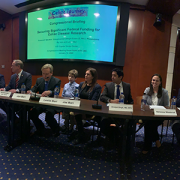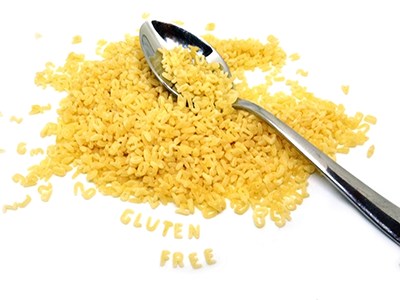Talking on Capitol Hill about the need for increased celiac research funding

Celiac Disease Program leaders joined policymakers, experts and families to make the case for additional celiac disease research funding on Capitol Hill in January 2020.
Federal funding for celiac disease has been virtually nonexistent, despite the fact that celiac is one of the most common genetic autoimmune disorders. The lack of funding directly translates into a shortage of research into better understanding celiac disease, its mechanisms and potential treatment alternatives to the strict diet that is the current standard of care.
In January, the leaders of the Celiac Disease Program at Children’s National Hospital, Dr. Benny Kerzner and Vanessa Weisbrod, gave oral testimony as part of a congressional briefing hosted by Congressman Dwight Evans (PA) on the need for significant research funding in this area. Also presenting were Jon and Leslie Bari, founders of Celiac Journey and Gluten Free Finds PA, who are parents of a child with celiac, as well as Dr. Arjunot Singh, attending physician in gastroenterology at Children’s Hospital of Philadelphia.
The briefing focused on how federal funding for celiac research could bring multi-center, large scale research projects to the study of the condition for the first time, with the goal of accomplishing the following:
- Better understanding the immunological basis of the disease
- Identifying celiac disease’s triggers and how to prevent them
- Exploring potential treatments and/or cures, including those that might inhibit onset of the disease or induce tolerance of the gluten protein
In their testimony, Kerzner and Weisbrod noted that the only current treatment for celiac disease is a strict, lifelong gluten-free diet, and that there is no medication or cure for the condition. Parents and children alike struggle with managing the diet and coping with the persistent fear of increased mortality from other conditions that commonly co-occur with celiac disease, including non-Hodgkins lymphoma, liver disease, small bowel cancers and other autoimmune conditions.
Weisbrod also spoke about an existing collaborative research and care infrastructure called the Celiac Kids Network – an informal consortium of 12 pediatric hospitals with celiac programs that research together, develop tools to measure gluten exposure risks, share best practices and collaborate on difficult cases. She made the case that should federal funding significantly increase, infrastructure is already in place to manage and oversee the types of research collaborations that could really make a difference for children.
“We dream of establishing a learning health system with a coordinated patient registry that is representative of all patients with celiac disease no matter where in the country they live,” Weisbrod concluded in her testimony. “A national biorepository of patient blood and tissue samples would enable researchers from every medical discipline to join us in understanding how celiac disease affects kids. We could evaluate the biological and psychological outcomes of patients to look for interventions to improve quality of life. The sky is the limit. But to do this, we need big funding to collect big data, to make big differences.”





